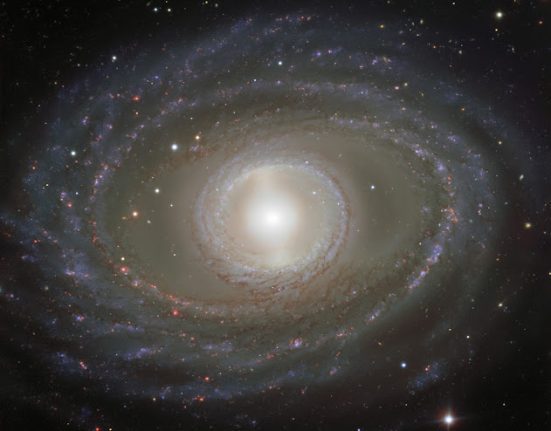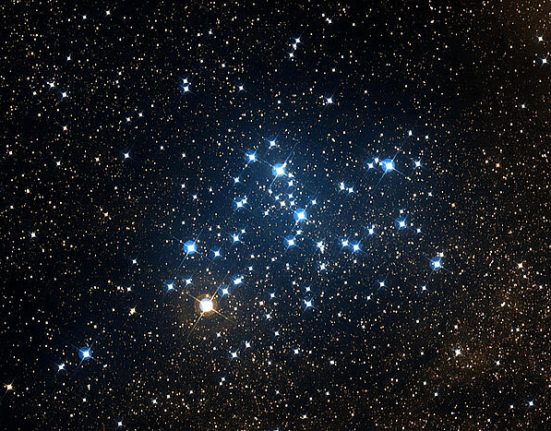Using data from NASA's retired Spitzer Space Telescope, scientists have gained new insights into the feeding habits of supermassive black holes at the centers of galaxies across the universe. These black holes often fluctuate in brightness due to the huge clumps of cosmic material falling into them.
However, this is not true for black holes located at the centers of the Milky Way and the Andromeda galaxies. Instead, they remain fairly quiet and rarely vary in brightness. To find the cause of the decline in activity around black holes, a new study used observations from Spitzer and Hubble to model the black hole and the material surrounding it at the center of the Andromeda galaxy.
In the Spitzer images, long streams of dust spanning thousands of light years in length can be seen flowing toward the supermassive black hole at the center of the Andromeda Galaxy, the closest major galaxy to Earth, located about 2, 5 million light years. far.
As cosmic gas and dust fall into supermassive black holes, like the one located in Andromeda, the material heats up and begins to glow, creating light shows around the black hole that can outshine entire galaxies. However, this material is not absorbed all at once. Instead, the material is consumed in clumps that vary in size, causing the black hole's brightness to fluctuate.

Close view of the center of the Andromeda galaxy, taken by the Spitzer Space Telescope. The blue dotted lines highlight the path of two streams flowing toward the black hole at the center of the galaxy. (Credit: NASA/JPL-Caltech)
Interestingly, the supermassive black holes located at the center of the Milky Way and Andromeda are among the quietest black holes known in the universe when it comes to consuming (or “eating”) cosmic material. When light is emitted by black holes, the brightness of the light does not vary significantly, which could mean that black holes are fed by a small, constant stream of cosmic material rather than clumps of material of different sizes.
Earlier this year, a team of scientists applied the hypothesis of a black hole feeding on a small, constant stream of cosmic material to the Andromeda galaxy and simulated how the gas and dust around the black hole would behave over time. of Andromeda. The simulation revealed that a small disk of hot gas could form near the black hole and continuously provide it with a flow of cosmic material. The disc can constantly provide material because the disc is replenished by numerous gas and dust streams.
However, the team also discovered that the currents that replenish the disk must remain within a certain size and flow rate. If they become too large or too small, the material would fall into the black hole in clumps of various sizes, causing the black hole's brightness to fluctuate, something the Milky Way and Andromeda black holes do not do.
Recalling previous observations of Andromeda by NASA's Hubble Space Telescope and Spitzer, scientists found dust spirals that fit the constraints highlighted by the simulation. Using these images, the team concluded that the spirals were indeed feeding the supermassive black hole at the center of Andromeda. This result also means that a similar process is likely taking place at the center of the Milky Way, given that the two black holes exhibit similar behaviors and characteristics.
“This is a great example of how scientists reexamine archival data to reveal more about the dynamics of galaxies by comparing it to the latest computer simulations. “We have data from 20 years ago that tells us things we didn't recognize when we first collected it,” said co-author Almudena Prieta, from the Institute of Astrophysics of the Canary Islands and the University of Munich Observatory.

Image of the center and outer regions of the Andromeda galaxy, taken by Hubble in visible light. (Credit: NASA/ESA/J. Dalcanton (University of Washington, USA)/BF Williams (University of Washington, USA)/LC Johnson (University of Washington, USA)/The PHAT Team /R. Gendler)
As mentioned, images from Spitzer were used to confirm the scientists' hypothesis. Spitzer was launched in August 2003 aboard a Delta II from Cape Canaveral Air Force Station and was the third telescope dedicated exclusively to observing the universe in infrared. The joint James Webb Space Telescope of NASA, the European Space Agency and the Canadian Space Agency is another telescope that observes exclusively in infrared. Infrared observation has many advantages, notably that it gives scientists the ability to see through thick layers of dust that are present in galaxies and other cosmic objects, as well as the ability to see into the early universe.
Spitzer's observations of Andromeda were made using different wavelengths, each revealing different features of the galaxy, such as stars and dust structures. By separating the wavelengths and looking only at the dust, scientists were able to see the galaxy's “skeleton,” or regions where gas has coalesced and cooled, creating stellar nurseries where young stars can form.
Seeing the galaxy this way surprised scientists. One surprise was that Andromeda is dominated by a large dust ring rather than conventional distinct arms surrounding the center of the galaxy. In addition, a large hole was found inside the ring through which a dwarf galaxy passed.

Infrared images from Spitzer showing dust inside Andromeda. (Credit: NASA/JPL-Caltech/University of Arizona)
Although Spitzer has a wider field of view than Hubble, the telescope had to take about 11,000 images of the galaxy to create the image used in the study.
The team's results were published in The Astrophysical Magazine.
(Main image: The Andromeda Galaxy seen in infrared by the Spitzer Space Telescope. Credit: NASA/JPL-Caltech/University of Arizona)













Leave feedback about this